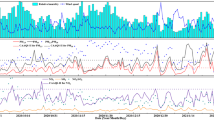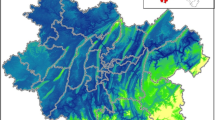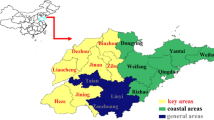Abstract
We investigated recent ambient air quality and pollution in Zhangjiakou, China, from 2016 to 2020 by analyzing the interannual variability in the air quality index (AQI) variations, interannual and monthly tends of six conventional air quality indices, index-ratio characteristics, and correlations. We employed a Gray model for predicting air pollution control, providing insight into measures that may improve air quality during the coming 2022 Olympic Winter Games in Beijing and Zhangjiakou. The results showed that PM2.5 and PM10 (produced by industrial sources, coal consumption, vehicle emissions, and dust) increased in spring and decreased in summer; because the dust levels in Zhangjiakou are highest in spring, the PM2.5 and PM10 concentrations were higher in spring than in winter. SO2, NO2, and CO increased in winter and decreased in summer, SO2 and CO are primarily affected by heat, and NO2 is mainly affected by vehicle emissions. Monthly O3 concentrations increased in summer and decreased in winter, owing to meteorological conditions, such as solar radiation and air temperature. Pearson’s correlation analysis suggested that PM10, PM2.5, NO2, CO, and SO2 are positively correlated and have similar emission patterns; while O3 is strongly negatively correlated with NO2, albeit less so in summer. According to backward trajectory and concentration-weighted trajectory (CWT) analysis, the February fine particulate pollution in Zhangjiakou was not only affected by local pollutants but also by pollutants from parts of Inner Mongolia, northern Shanxi, Mongolia, and other regions. We predict that the Zhangjiakou air quality during the 2022 Winter Olympics will be generally acceptable, but fine particulate matter concentrations may increase, presenting a human health risk.













Similar content being viewed by others
Data availability
This study included hourly Zhangjiakou AQI data and the concentrations of six air pollutants (i.e., PM2.5, PM10, SO2, NO2, O3, and CO), from 2016 to 2020 (source: China National Environment Monitoring Center Data; http://106.37.208.233:20035/); and AQI data from February 4–20, 2021 was taken from the Zhangjiakou Ecological Environment Bureau (http://hb.zjk.gov.cn/).
Code availability
Not applicable.
References
Adame J-A, Notario A, Villunueva F, Albaladejo J (2012) Application of cluster analysis to surface ozone, NO 2 and SO2daily patterns in an industrial area in Central-Southern Spain measured with a DOAS system. Sci Total Environ 429:281–291. https://doi.org/10.1016/j.scitotenv.2012.04.032
Bin Z (2007) Study on the emission of air pollution sources in North China. Chinese Academy of Meteorological Sciences
Chai F, Gao J, Chen Z, et al. (2014) Spatial and temporal variation of particulate matter and gaseous pollutants in 26 cities in China. J Environ Sci 26(1). https://doi.org/10.1016/S1001-0742(13)60383-6
Chen S-F, Guo J-P, Song L-Y, Jason B-C, Wang Y (2020) Intra-seasonal differences in the atmospheric systems contributing to interannual variations of autumn haze pollution in the North China Plain. Theor Appl Climatol 1-15. https://doi.org/10.1007/s00704-020-03221-4
Dorling S-R, Davies T-D, Pierce C-E (1992) Cluster analysis: a technique for estimating the synoptic meteorological controls on air and precipitation chemistry. Method Appl Atmos Environ 26(14):2575–2581. https://doi.org/10.1016/0960-1686(92)90110-7
Fang X-J, Xiao H-Y, Liang Y, Xie Y-J, Liu C, Wang F (2020) Study on the characteristics of air pollution in Zhangjiakou from 2015 to 2018. J East China Univ Technol (Nat Sci 43: 553–559. https://kns-cnki-net-443.v.cnu.edu.cn/kcms/detail/detail.aspx?FileName=HDDZ202006008&DbName=CJFQ2020
He J-J, Gong S-L, Yu Y, Yu L-J, Wu L, Mao H-J, Song C-B, Zhao S-P, Liu H-L, Li X-Y, Li R-P (2017) Air pollution characteristics and their relation to meteorological conditions during 2014–2015 in major Chinese cities. Environ Pollut 223:484–496. https://doi.org/10.1016/j.envpol.2017.01.050
Hu W-Y, Zhao T-L, Bai Y-Q, Shen L-J, Sun X-Y, Gu Y (2020) Contribution of regional PM2.5 transport to air pollution enhanced by sub-basin topography: a modeling case over Central China. Atmosphere 11:1258–1258. https://doi.org/10.3390/atmos11111258
Hui G-J, Bin Z, Dong D-W (2012). The variation of air pollutants and the impact of long-range transport in the northern suburb of Nanjing. 32: 1149–1159. Acta Sci Circumstantiae https://kns-cnki-net-443.v.cnu.edu.cn/kcms/detail/detail.aspx?FileName=HJXX201205020&DbName=CJFQ2012
Jia M-W, Zhao T-L, Cheng X-H, Gong S-L, Zhang X-Z, Tang L-L, Liu D-Y, Wu X-H, Wang L-M, Chen Y-S (2017) Inverse relations of PM2.5 and O3 in air compound pollution between cold and hot seasons over an urban area of East China. Atmos 8(3):59. https://doi.org/10.3390/atmos8030059
Jin X-P, Cai X-H, Huang Q-Q, Wang X-S, Song Y, Zhu T (2021) Atmospheric boundary layer—free troposphere air exchange in the North China Plain and its impact on PM2.5 pollution. J Geophys Res Atmos 126:9. https://doi.org/10.1029/2021JD034641
Kang HY, Liu YL, Li T 2017). Characteristics of air quality index and its relationship with meteorological factors in key cities of Heilongjiang Province. J Nat Res 32: 692–703. https://kns-cnki-net-443.v.cnu.edu.cn/kcms/detail/detail.aspx?FileName=ZRZX201704014&DbName=CJFQ2017
Karaca F, Anil I, Alagha O (2009) Long-range potential source contributions of episodic aerosol events to PM10 profile of a megacity. Atmos Environ 43(36):5713–5722. https://doi.org/10.1016/j.atmosenv.2009.08.005
Lang J. L, Cheng S. Y.C, Han L. H (2012). Vehicular emission characteristics in the Beijing-Tianjin-Hebei (BTH) region. J Beijing Univ Technol 38(11): 1716–1723. https://kns-cnki-net-443.v.cnu.edu.cn/kcms/detail/detail.aspx?FileName=BJGD201211024&DbName=CJFQ2012
Li S-W, Shi J-W (2007) A study of grey numerical model of air pollution. Journal of Grey System 19:39–47
Li Y, Wang W, Wang J-Z, Zhang X-L, Lin W-L, Yang Y-Q (2011) Impact of air pollution control measures and weather conditions on asthma during the 2008 Summer Olympic Games in Beijing. Int J Biometeorol 55(4):547–554. https://doi.org/10.1007/s00484-010-0373-6
Li X-F, Zhang M-J, Wang S-J, Zhao A-F, Ma Q (2012) Variation characteristics and influencing factors of air pollution index in China. Environ Sci 33(6):1936–1943. https://doi.org/10.13227/j.hjkx.2012.06.035
Liang P-F, Zhu T, Fang Y-H, Li Y-R, Han Y-Q, Wu Y-S, Hu M, Wang J-X (2017) The role of meteorological conditions and pollution control strategies in reducing air pollution in Beijing during APEC 2014 and Victory Parade 2015. Atmos Chem Phys 17(22):13921–13940. https://doi.org/10.5194/acp-17-13921-2017
Liu X-X, Xue A (2006). Grey prediction of air quality in Beijing in 2008. Environ Eng, (02):69–76. NKI:SUN:HJGC.0.2006–02–024
Liu S-S, Yuan J-G (2020). Spatial and temporal variations of NO2 density in Beijing-Tianjin-Hebei air pollution transmission path cities from 2006 to 2017. Earth Environ 48: 171–180. https://kns-cnki-net-443.v.cnu.edu.cn/kcms/detail/detail.aspx?FileName=DZDQ202002002&DbName=DKFX2020
Maryer H (1999). Air pollution in cities. Atmos Environ 3(24). https://doi.org/10.1016/S1352-2310(99)00144-2
Mei Y (2019). Emission inventory of air pollution sources in Shijiazhuang City. Hebei Normal University
Meng Z-Y, Xu X-B, Wang T, Zhang X-Ying, Yu X-Lan, Wang S-F, Lin W-L, Chen Y-Z, Jiang Y-A, An X-Q (2010) Ambient sulfur dioxide, nitrogen dioxide, and ammonia at ten background and rural sites in China during 2007–2008. Atmos Environ 44(21):2625–2631. https://doi.org/10.1016/j.atmosenv.2010.04.008
Meng C-C, Ni S-Y, Lu Y-J (2019). Emission inventory and emission reduction potential of typical industrial sources in Hebei Province. Environ Sci Technol 42(S2): 186–193. https://kns-cnki-net-443.v.cnu.edu.cn/kcms/detail/detail.aspx?FileName=FJKS2019S2031&DbName=CJFQ2019
Pan Z-H, Wei J-D, Xia Z-G (2007). Application of dynamic Gray model in deformation forecast. Sci Surv Mapp (04): 121–123+197. https://kns-cnki-net-443.v.cnu.edu.cn/kcms/detail/detail.aspx?FileName=CHKD200704046&DbName=CJFQ2007
Pateraki St, Asimakopoulos DN, Flocas HA, Maggos Th, Vasilakos Ch (2012) The role of meteorology on different sized aerosol fractions (PM 10, PM 2.5, PM 2.5–10). Sci Total Environ 419:124–135. https://doi.org/10.1016/j.scitotenv.2011.12.064
Qian T, Bo Z, Wen B-X (2010) Contributors to air pollutant emission changes in autumn and winter in Beijing-Tianjin-Hebei and surrounding areas. Environ Sci 42:1591–1599. https://doi.org/10.13227/J.HJKX.202007218
Ruttanawongchai S, Raktham C, Khumsaeng T (2018) The influence of meteorology on ambient PM2.5 and PM10 concentration in Chiang Mai. J Phys Conf Ser 1144. https://doi.org/10.1088/1742-6596/1144/1/012088
Shen F, Ge X, Hu J, et al (2017). Air pollution characteristics and health risks in Henan Province. Environ Res 32 (04): 692- 703. https://kns-cnki-net-443.v.cnu.edu.cn/kcms/detail/detail.aspx?FileName=ZRZX201704014&DbName=CJFQ2017
Sun C, Cao B,Zhang X-H, Liu X-Y, Sun Q-H (2020). Prediction of air pollutants in China from 2019 to 2023. 2020 annual meeting of science and technology of Chinese society of Environmental Sciences. 916–923. https://doi.org/10.26914/c.cnkihy.2020.040495
Tsai W-T, Lin Y-Q (2021) Trend analysis of air quality index (AQI) and greenhouse gas (GHG) emissions in Taiwan and their regulatory countermeasures. Environments 8(4):29–29. https://doi.org/10.3390/ENVIRONMENTS8040029
Wang Z-S, Li Y-T, Zhang D-W, (2018). Concentration level and spatiotemporal characteristics of CO in Beijing in 2014. Environmental Monitoring in China 34: 14–20. https://kns-cnki-net-443.v.cnu.edu.cn/kcms/detail/detail.aspx?FileName=IAOB201803003&DbName=CJFQ2018
Wang M-Y (2020) Study on construction cost evaluation of construction project under dust control. Zhengzhou University
Wen T-X, Wang Y-S, Zhang K (2007). Study on sulfate and sulfur oxidation ratio in PM10 during heating season in Beijing. J Univ Chin Acad Sci (05): 584–589. https://kns-cnki-net-443.v.cnu.edu.cn/kcms/detail/detail.aspx?FileName=ZKYB200705005&DbName=CJFQ2007
WU Y(1999). Discussion on the application scope of grey system model GM (1,1). J Beijing Univ Technol 25(01): 72–75. CNKI:SUN:BJGD.0.1999-01-013
Xin J-Y, Wang Y-S, Tang G-Q, et al (2010). Reduction and change of air pollutants in Beijing and surrounding areas during 2008 Olympic Games. 55(15): 1512–1521. Chin Sci Bull. https://kns-cnki-net-443.v.cnu.edu.cn/kcms/detail/detail.aspx?FileName=KXTB201015014&DbName=CJFQ2010
Xu X, Akhtar U-S (2010) Identification of potential regional sources of atmospheric total gaseous mercury in Windsor, Ontario, Canada using hybrid receptor modeling. Atmos Chem Phys 10(15):7073–7083. https://doi.org/10.5194/acp-10-7073-2010
Xu L-J, Zhou J-X, Guo Y, Wu T-M, Chen T-T, Zhong Q-J, Yuan D, Chen P-Y, Ou C-Q (2017) Spatiotemporal pattern of air quality index and its associated factors in 31 Chinese provincial capital cities. Air Qual Atmos Health 10(5):601–609. https://doi.org/10.1007/s11869-016-0454-8
Xu W, Liu X, Liu L, Dore A-J, Tang A, Lu L, Wu Q-H, Zhang Y-Y, Hao T-X, Pan Y-P, Chen J-M, Zhang F-S (2019) Impact of emission controls on air quality in Beijing during APEC 2014: implications from water-soluble ions and carbonaceous aerosol in PM 2.5 and their precursors. Atmos Environ 210:241–252. https://doi.org/10.1016/j.atmosenv.2019.04.050
Xu C-X, Lu C-X, Huang S-L, Dore A-J, Tang A, Lu L, Wu Q-H, Zhang Y-Y, Hao T-X, Pan Y-P, Chen J-M, Zhang F-S (2020) Study on ecological vulnerability and its influencing factors in Zhangjiakou area. J Nat Resour 35(06):1288–1300. https://doi.org/10.1016/j.atmosenv.2019.04.050
Yan Y-C, Liu Z-R, Gao W-K, Li J-Y, Zhang X-H, Chai W-H, Bai J-H, Hu B, Wang Y-S (2021) Physiochemistry characteristics and sources of submicron aerosols at the background area of North China Plain: implication of air pollution control in heating season. Atmos Res 249:105291. https://doi.org/10.1016/J.ATMOSRES.2020.105291
Yan H-H, Chen LF, Tao J-H (2017). SO2 long-term monitoring by satellite in the Pearl River Delta. Natl Remote Sens Bull 16: 390–404. https://kns-cnki-net-443.v.cnu.edu.cn/kcms/detail/detail.aspx?FileName=YGXB201202014&DbName=CJFQ2012
Yao CQ, Zhi XX, Yang L (2019) Review of research on the impacts of atmospheric pollution on the health of residents. Environ Sci 40(03):1512–1520. https://doi.org/10.1007/s11869-016-0454-8
Zhang W, Zhu T, Yang W, Bai Z, Sun Y-L, Xu Y, Yin B, Zhao X (2014b) Airborne measurements of gas and particle pollutants during CAREBeijing-2008. Atmos Chem Phys 14(1):301–316. https://doi.org/10.5194/acp-14-301-2014.Z
Zhang H-X, Sun X, Yao Y-H, (2014). Ground-level ozone distribution pattern in summer of Beijing and its foliar injury effect upon plants. Acta Ecol Sin 34: 4756–4765. https://kns-cnki-net-443.v.cnu.edu.cn/kcms/detail/detail.aspx?FileName=STXB201416032&DbName=CJFQ2014
Zhao H-J, Zhou Y-L, Liu J-Y (2014). Temperature inversion characteristics of low-air atmosphere in Zhangjiakou City. J Arid Land Resour Environ 28: 171–175. https://kns-cnki-net-443.v.cnu.edu.cn/kcms/detail/detail.aspx?FileName=GHZH201405029&DbName=CJFQ2014
Zhao X-M (2018). Prediction of air pollutant concentration in Beijing based on Grey GM (1,1) prediction model. J North China Univ Technol 30(05): 47–51. CNKI:SUN:BFGY.0.2018-05-010
Zhen B-F, You H, Gong X-F (2010). An approach on the models for air pollution forecast. J Nanchang Univ (Eng Technol (01): 78–83. https://kns-cnki-net-443.v.cnu.edu.cn/kcms/detail/detail.aspx?FileName=NCDG200001015&DbName=CJFQ2000
Zhou H, Jiang M-D, Huang Y-M, Wang Q (2021) Directional spatial spillover effects and driving factors of haze pollution in North China Plain 126. Resour Conserv Recycl. https://doi.org/10.1016/J.RESCONREC.2021.105475
Acknowledgements
This work was supported by the National Key R&D Program of China and the National Natural Science Fundation of China.
Funding
National Key R&D Program of China (grants 2018YFC0706004, 2018YFC0706000 and 2018YFC1508902) and National Natural Science Foundation of China (grant 42071422).
Key Technology Research and Development Program of Shandong, 2018YFC0706004, Wenji Zhao, National Natural Science Foundation of China, 42071422, Wenji Zhao
Author information
Authors and Affiliations
Contributions
All authors contributed to the study conception and design. Material preparation, data collection, and analysis were performed by MW, TL, NS, and LW. The first draft of the manuscript was written by MW, and all authors contributed to manuscript revision, read, and approved the submitted version.
Corresponding author
Ethics declarations
Ethics approval and consent to participate
Not applicable.
Consent for publication
Not applicable.
Competing interests
The authors declare no competing interests.
Additional information
Publisher's note
Springer Nature remains neutral with regard to jurisdictional claims in published maps and institutional affiliations.
Rights and permissions
About this article
Cite this article
Wang, M., Zhao, W., Li, L. et al. Air quality assessment and Gray model prediction for the 2022 Winter Olympics in Zhangjiakou, China. Air Qual Atmos Health 15, 1303–1315 (2022). https://doi.org/10.1007/s11869-022-01152-9
Received:
Accepted:
Published:
Issue Date:
DOI: https://doi.org/10.1007/s11869-022-01152-9




